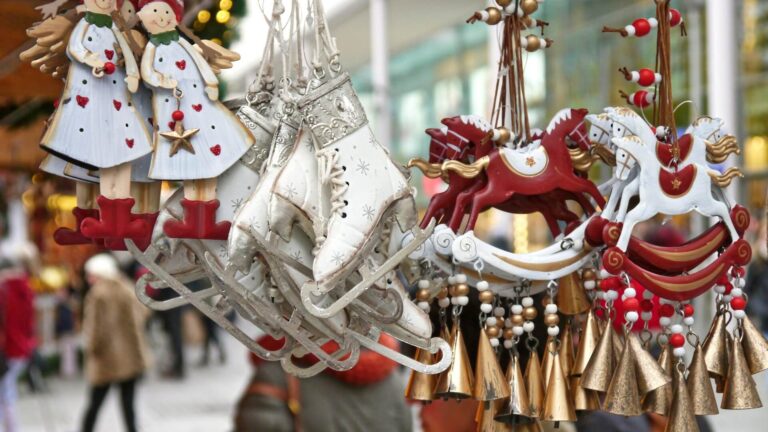
If you need a freelance travel writer or you would like to see your country, city, flight, etc., presented on the blog, drop me an email.
Find our more on Freelance Travel Writer page.
Here are things to do in Ronda Spain, the place often referred to as “the town on the cliff” where bullfighting originated from. When you travel to Andalusia, visiting Ronda is a must. If you ever admired its photos, you will be blown away by its steep gorge in person!
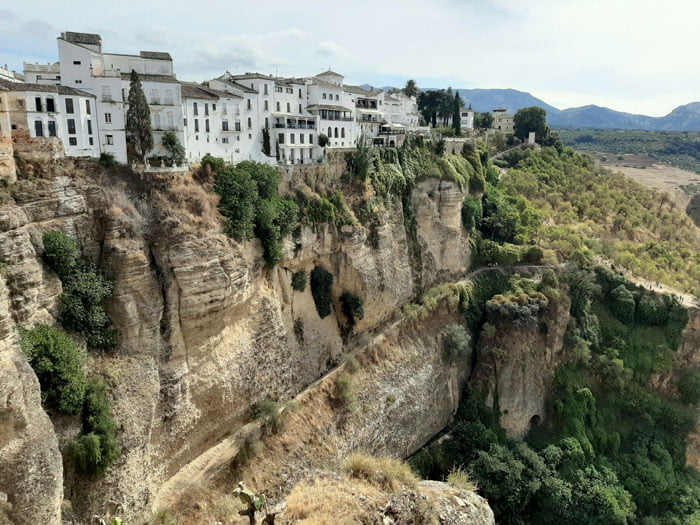
RONDA SPAIN
The place to establish a settlement was probably chosen by Iberian tribes or Celts. It wasn’t until Romans took over when the village was named Arunda that literary means “surrounded by mountains”. There is evidence that behind its walls Roman chariot races took place for decades. Never the less, after Romans left, the settlement increasingly declined until Moors came and recognized its strategic importance once again. Thus, the town began to flourish since 713 AD. Then came Christians in the 15th century, and the town remained a battleground for various clashes throughout centuries. During the 20th-century civil war, guerilla fighters hid in surrounding forests which led to all the buses having a military escort until the 1960’s.
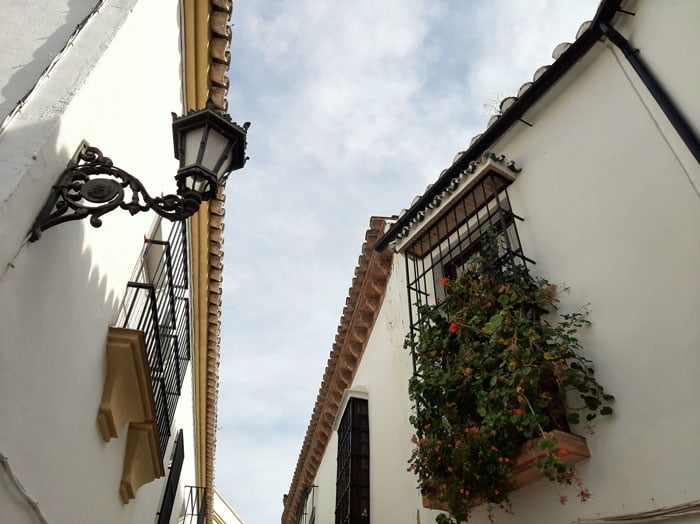
In time, Ronda became known as “the Eagle’s Nest”. This deliberate irony was meant to refer not only to a place on the mountaintop but to the cunning ferocity of its citizens as well. The town’s location was not chosen by accident though. Ronda was to be defended from the intruders, who were easy to spot from these inaccessible cliffs.
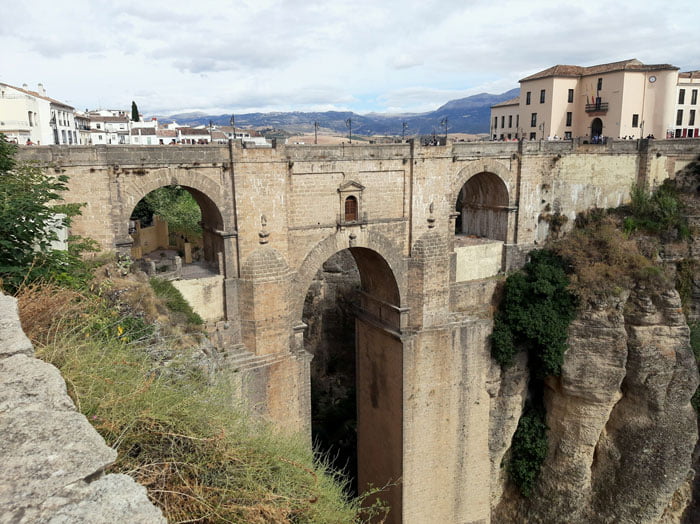
One’s wanderlust rises even more after reading something like this! Tourists usually take a day trip here from Malaga, but my journey was a bit different. My things to do in Ronda Spain bucket list began by taking a bus from Arcos de la Frontera, and I left for Malaga in the evening. It took me an hour and a half to get here.
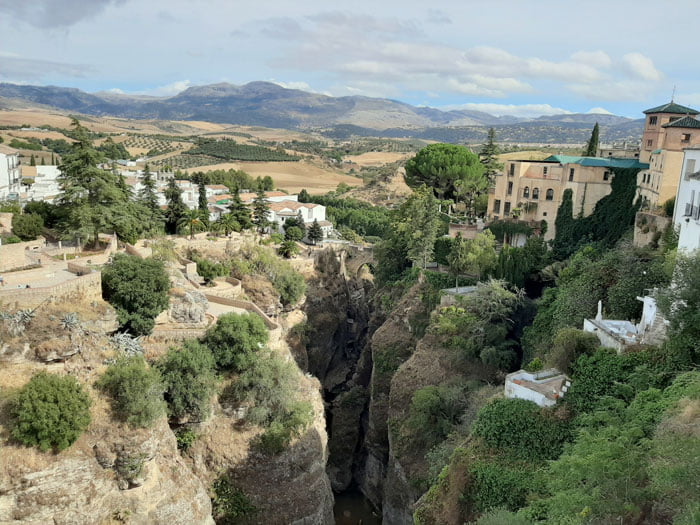
TIP: Check the bus timetable and buy the ticket online at least a day prior to the trip. It so happened, for instance, that there was only one departure per day from Arcos which would be easy to miss. Also, you can’t be sure if the bus station counter even works on weekends and holidays.
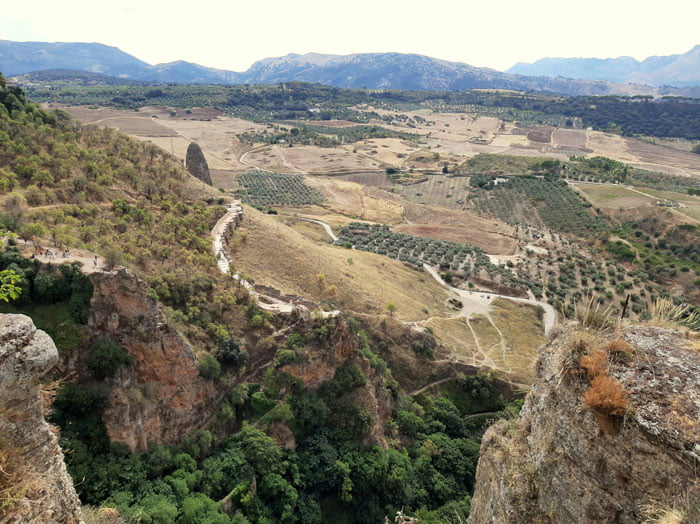
The ticket from Arcos was less than 12 Euros and towards Malaga another 13. The station was not far from the center, it takes about 10 minutes or so to walk to the bullfighting arena, and five more to see the Puente Nuevo (the New Bridge).

TIP: If you are not planning to sleep in Ronda, leave your bags at the station. I was charged 5 Euros at the improvised stockroom at the very bus station (where everything was closed, even lockers since it was Sunday), and the woman from the small shop just wrote me a note on a piece of paper. Still, everything was fine when I got back, my things were there.
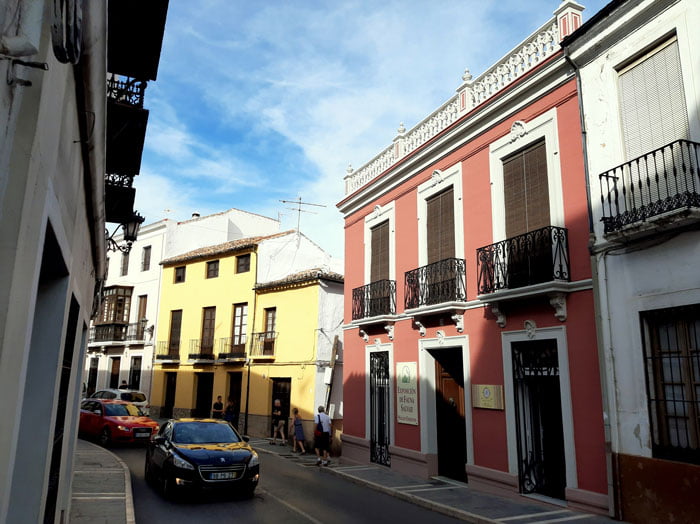
RONDA BRIDGE
The New Bridge or Puente Nuevo was finished in 1793, after 40 years of construction during which 50 workers died. The bridge connected opposite cliffs of the 100-meter-gorge El Tajo. Ronda was thus divided into the old and the new town. The story goes that even the New Bridge architect fell into the canyon few years after it was built, but there is evidence that he died by natural causes in Malaga in 1802. The bridge housed a prison in the middle of its construction.
There was one other earlier attempt during the 1730’s to build a bridge here, but it collapsed after six years, killing many in the process.
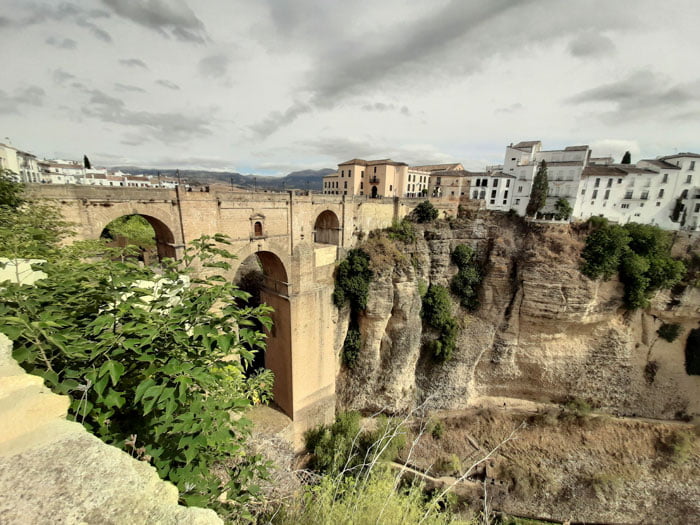
Although it makes you sigh today for being so picturesque, Puente Nuevo always had a dark side to it. Not only that it served as a prison, that the previous one collapsed and killed many, that many workers also died due to building it again, but murders, accidents, and suicides were always related to the Ronda bridge. They say that it often happens that one slips while trying to lean a bit more to get that perfect photo.
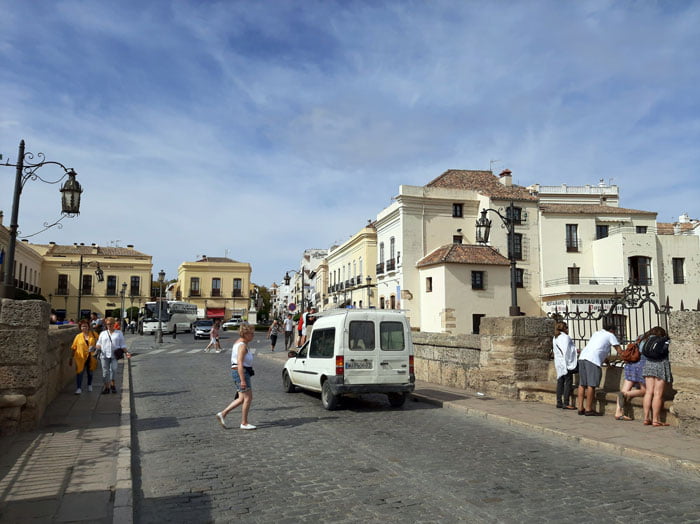
Anyway, this typical Andalusian “white village”, (pueblo blanco) actually became famous for its cliffs and viewpoints, as for the bridge over the El Tajo gorge through which the Guadalevin river flows. Puente Nuevo straddles over the deep chasm and the view stretches along the mountain range of Serrania de Ronda.
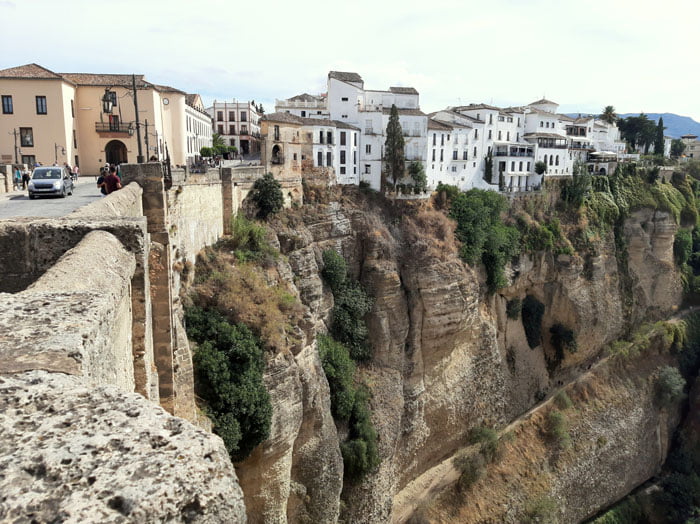
You will spend most of your time here. The bridge looks beautiful from above and below. There is a valley to admire on one side of it, while on the other you will see further into the canyon. The best photos are to be taken from the bridge itself, but also from a few lower viewpoints. There are also numerous restaurants to have a bite to eat with the view. My things to do in Ronda Spain included visiting all the landmarks first and then sitting down to relax and have lunch in one of the restaurants. The bus for Malaga was not leaving until the evening, so there was enough time. (At least that’s what I thought…)
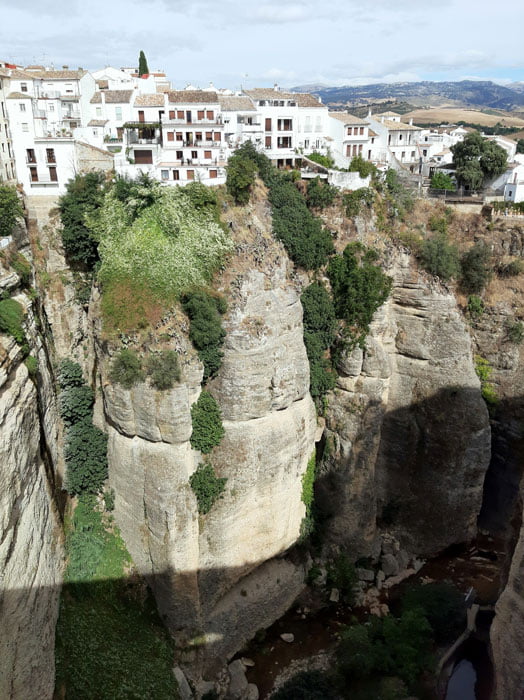
TIP: If you want to take some fine pictures of the bridge, continue to Plaza del Campillo, a small resting area in the old town, where you will find steps going all the way to the foothill. The stroll is steep and long, zig-zagging along the way, so you might want to consider a break halfway down with a nice viewpoint on the rock.
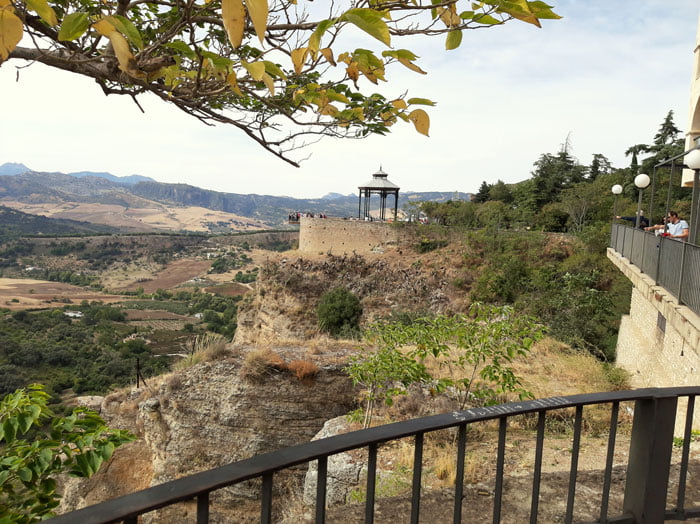
It wasn’t until I descended towards the viewpoint that I could really admire the bridge. It immediately springs up in front of you, along with those cliffs that looked so out of place. One could see the river beneath Puente Nuevo, tumbling down in a form of a nameless waterfall. Tourists could be discerned at the foothill, tiny as ants.

TIP: There is a bus that one should ask about at the Tourism Organization of Ronda (which closed early back then because it was Sunday), that can take you to the foothill of the cliff, but also through some of the important parts of Ronda. The ticket is 10 Euros and this is not a bad idea if you don’t have much time.
I rushed back (metaphorically speaking, since it was a bit impossible to climb up those steep steps that fast), because I couldn’t wait to get to – the bullfighting arena.
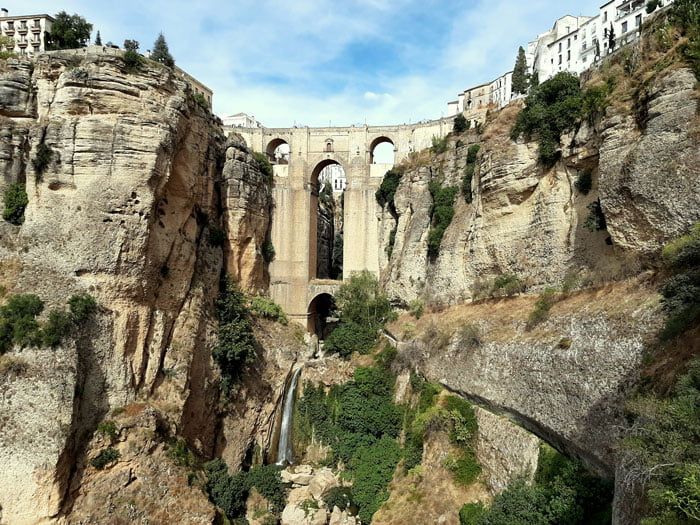
BULLFIGHTING IN RONDA
There is evidence that even in the Visigoths era in 5 AD there used to be some kind of a spectacle involving young men who provoked and leaped over bulls to prove their courage. Even though nobody knows when exactly the actual bullfighting began, Ronda is considered to be its cradle. Legendary Pedro Romero Martinez pushed it to glory in the 18th century when he abandoned the old way of riding horses, introducing the new rule for matadors to stand on their feet face to face with the bull. This kind of bullfighting made Ronda and Spain famous worldwide.
Bullfighting arena in Ronda is turned into a museum nowadays, but fights are still held every September during the festival dedicated to Romero.
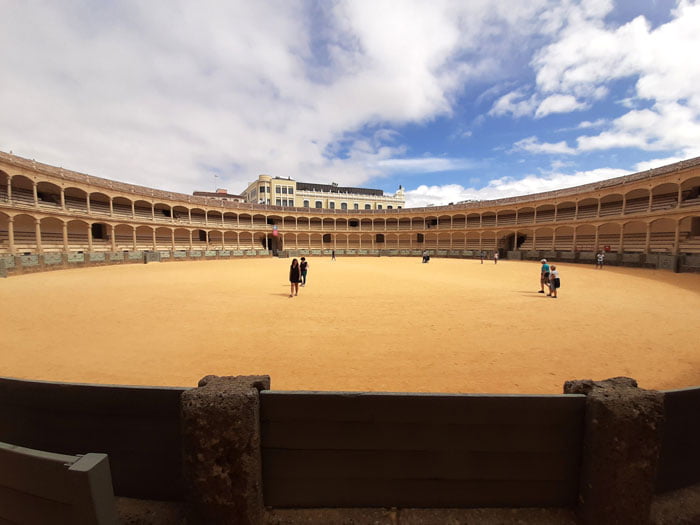
Whatever one may think about bullfighting, and however inappropriate the word “sport” might seem to refer to a “contest” that ends with killing an animal, one still can’t skip visiting the arena museum. That would be almost as though going to Seville without ever seeing the flamenco!
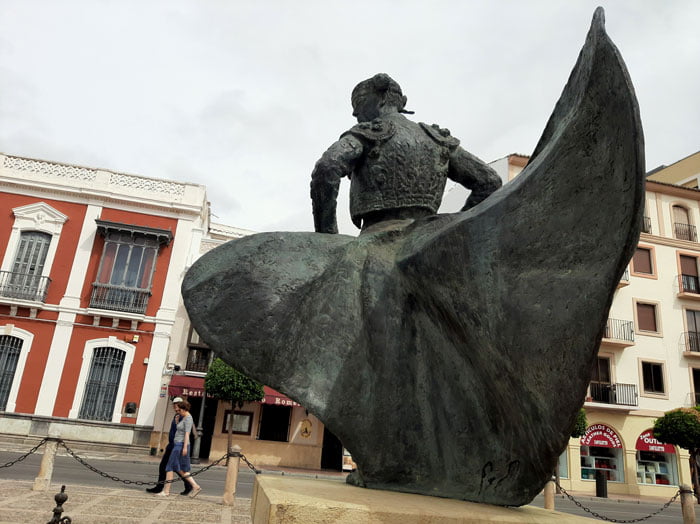
As soon as you approach the building, it’s clear where you are. There is a statue of a matador when coming from the street with his cape whirling up, iron handles on heavy doors are shaped like bullheads, while the life-sized-bull monument awaits next to the entrance.
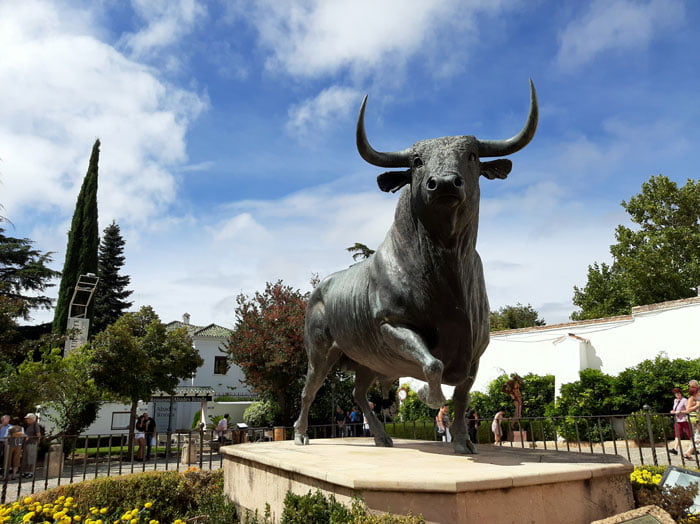
The entrance fee is 8 Euros and you will be able to see stables for horses, corridors for bulls waiting to come out, go through the area for visitors, and next to the small chapel where matadors say their final prayers before the show, along with the bullring itself. Although I knew what to expect, the vastness of the actual bullring with its 66-meter-diameter left me in awe. (There are also 136 pillars circling the seating area.)
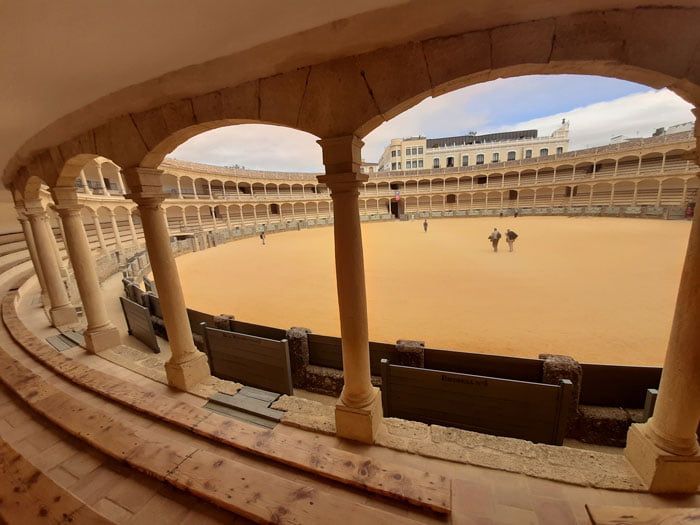
At the bullring named Plaza de Toros there is also a small museum exhibition to be seen with the matador’s traditional clothes, and more details about the “sport” and its development in Ronda. One gets fascinated by the fact that this is where it all began, but furthermore, there are some interesting old posters to be admired. One of them displays the name of the American Nobel Prize winner Ernest Hemingway.
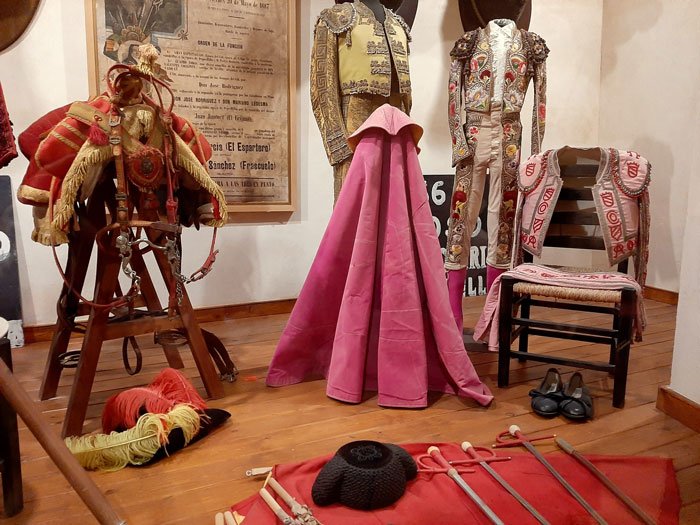
At the plateau in front of the bullring, you will find two busts dedicated to Hemingway and Orson Welles whom citizens of Ronda thanked in this way for their enthusiasm and support. (I already mentioned that Welles was a frequent visitor to the bullring of Seville where he watched bullfights with his wife Rita Hayworth, whose father originated from the city, remember?) Hemingway even has his one passage in Ronda.
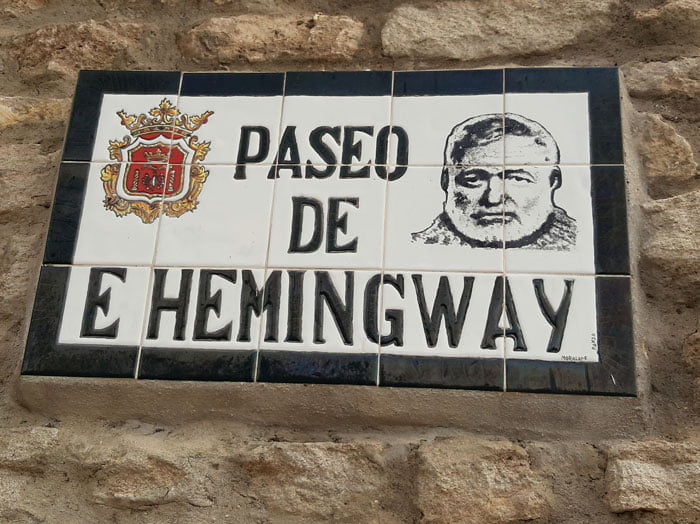
The fact is that if there weren’t for Hemingway, Pamplona would not be famous worldwide, and neither would the bullfighting itself in Ronda and Spain in general. He wrote about it in his books and newspaper articles. Also, a couple of the most famous matadors of the time were Hemingway’s close friends, one of whom became popular for going out with Hollywood celebrities (Ava Gardner for instance).
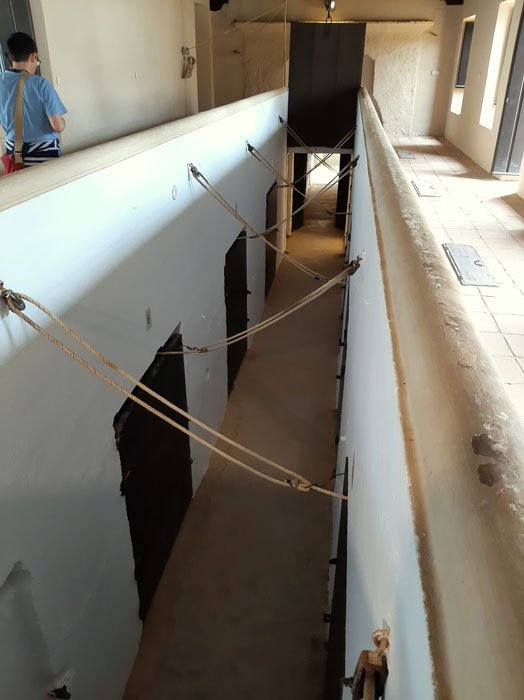
Few people know that Hemingway spent his last birthday in Andalusia. They say that it was one of the last times he would seem happy. Also, when he took his own life in America in 1961, there were bullfighting tickets found on his desk for the Pamplona show for the week ahead.
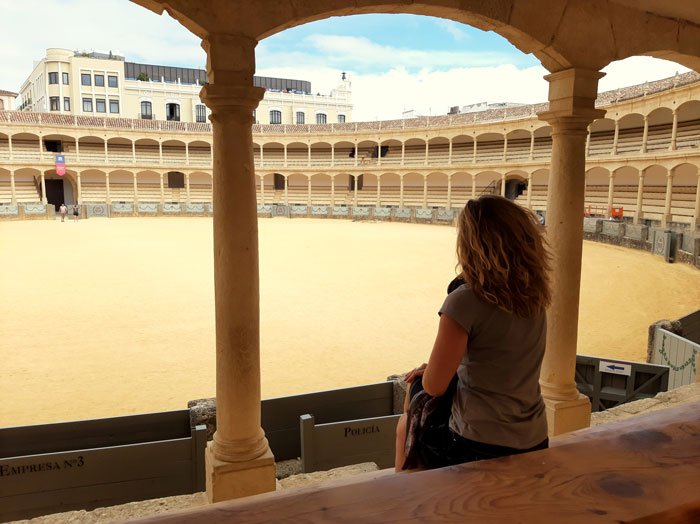
I get surprised sometimes by Hemingway’s footsteps I stumble upon throughout my journeys. His traces are hard to miss. (Remember Hemingway’s house in Cuba?)
Further behind these busts, there is one of the most popular viewpoints – Mirador de Ronda. It wasn’t on my bucket list, but it would be such a pity not to see it. (There will be enough time for everything, I hoped, even for that late lunch.) And the actual view was surreal!
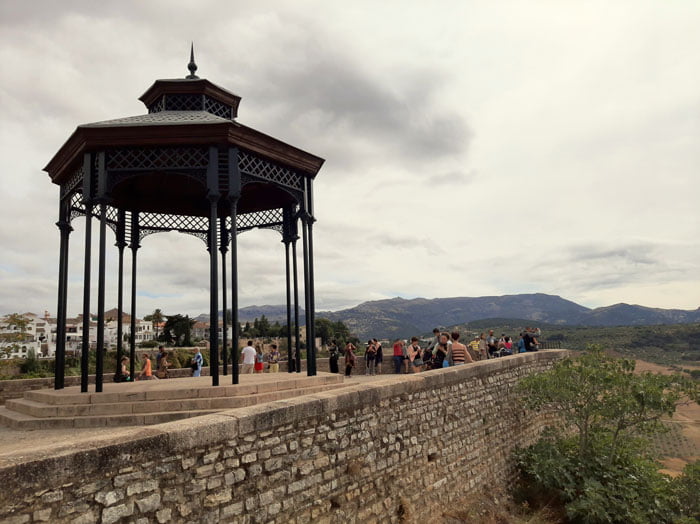
THE OLD TOWN
On the other side of the Puente Nuevo there lies La Ciudad or the old town of Ronda. It’s full of cobblestone streets, elegant mansions still belonging to the old families, small squares. One of the best known is the Palacio Mondragon which, although renovated few times, still preserves parts that were built during the rule of Moors when Ronda belonged to Cordoba caliphate in the 12th century. The building nowadays houses the history museum.
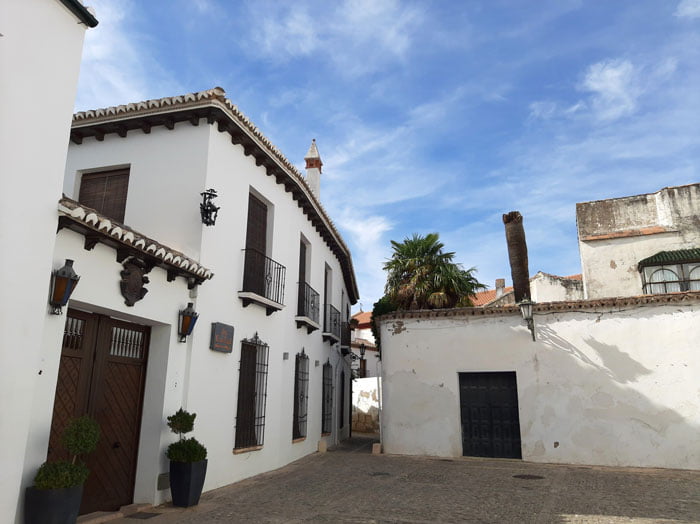
Charming narrow streets so typical for Andalusia are to be admired in La Ciudad. It’s easy to see why Ronda is one of the best-known “white villages” in Spain. When you come here during the siesta, for instance, it will seem like an open-air museum. As though no one comes in or out of those white-washed houses and only tourists still sneak around its cobbled streets. (I had enough time to get a bit lost again.)
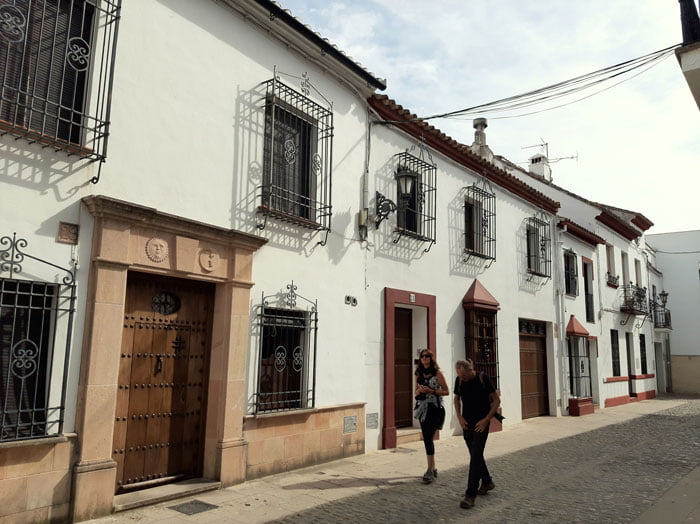
Palacio Mondragon can easily be missed, even though its façade is impressive. This palace is famous for its small Moorish water garden, designed to resemble Generalife in Granada. The building is not that big, but it still preserves some of interesting Moorish details, ceilings, balconies, and tiles.
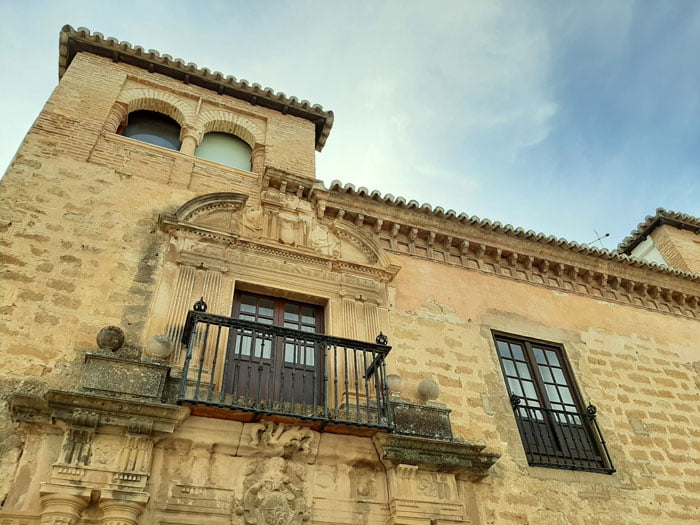
TIP: If visiting museums is on your bucket list, make sure to check the working hours before you come. Even though Ronda is extremely popular among tourists from around the world who come every day, weekends, lunch breaks, and siestas are widely respected here, as are in all of Andalusia. If planning on spending a day or two here, try to avoid weekends.
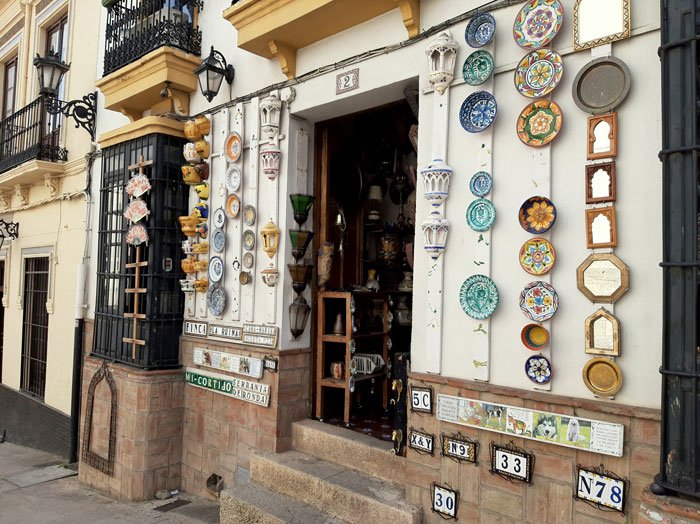
It’s hard not to spend more time in the old districts of Ronda because this is where everything that characterizes Andalusia comes to light. Fine façades, green treetops leaning over white walls, streets that curve somewhere, shops with colorful ceramic plates and pots. When you finally come out to one of the small squares, you get surprised by the number of people sitting outside. There will be galleries on one side, charming church bell towers peeking out on the other.

If I wasn’t startled by suddenly feeling hungry, I probably wouldn’t check the time. The plan was to check out all the things to do in Ronda Spain first, and then rest and have lunch. Where did the day go?! In less than an hour, I was supposed to take the Malaga bus and it will take me at least 30 minutes to find the station on foot again. And where to find a restaurant with an open kitchen at this hour…
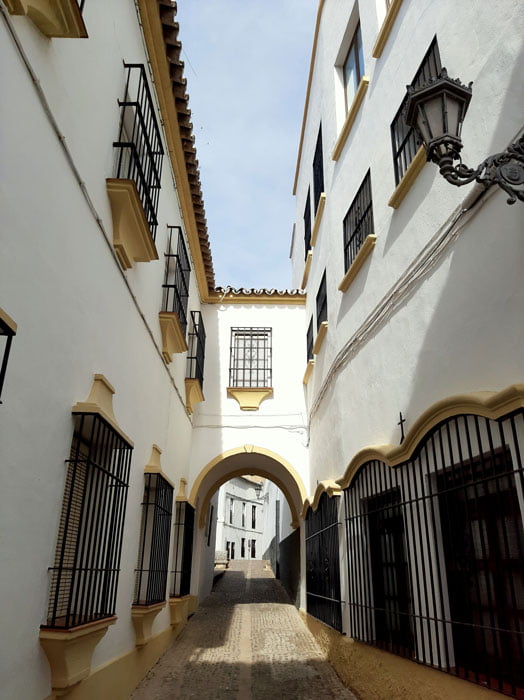
There was no time to waste, I just ran into the first “bocadillos” shop. While I was checking the traditional pastry (and I wanted to try a biscuit with cinnamon and almonds), the cost of the sandwich startled me by being pretty expensive compared to other parts of Andalusia. The lady turned to wrap it and handed me over almost – a meter-long sandwich! (I was probably supposed to indicate that I wanted “a small one” instead of the full baguette, filled with Spanish ham and cheese.)

The first bench (next to the Puente Nuevo) was mine. One bite after another… And the dusk was falling with some chilling breeze coming from the mountains. One doesn’t expect to feel chilled in September in Andalusia. The sandwich was gone. And there went the biscuit.

I had another 40 minutes left. Enough time for coffee and churros perhaps? Pulled a chair at one of the cafés, enjoying the view. And looking forward to that cozy Malaga hotel.
What a day!
What a journey!
The End
The full ANDALUSIA series

If you need a freelance travel writer or you would like to see your country, city, flight, etc., presented on the blog, drop me an email.
Find our more on Freelance Travel Writer page.
I am looking forward to working with you.
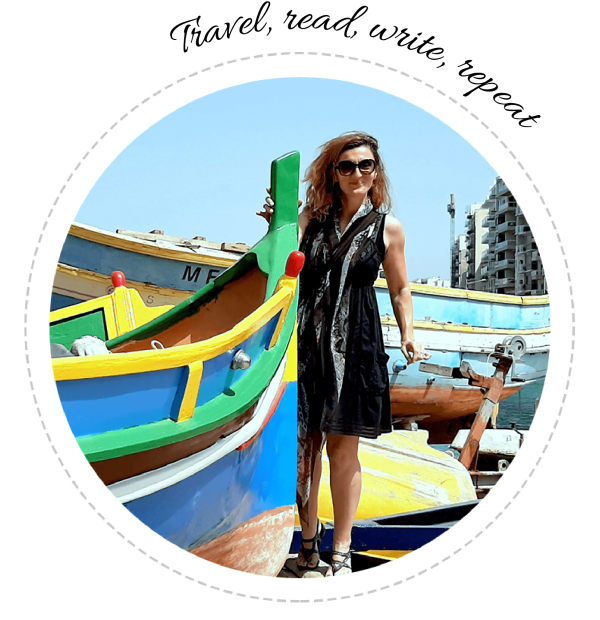


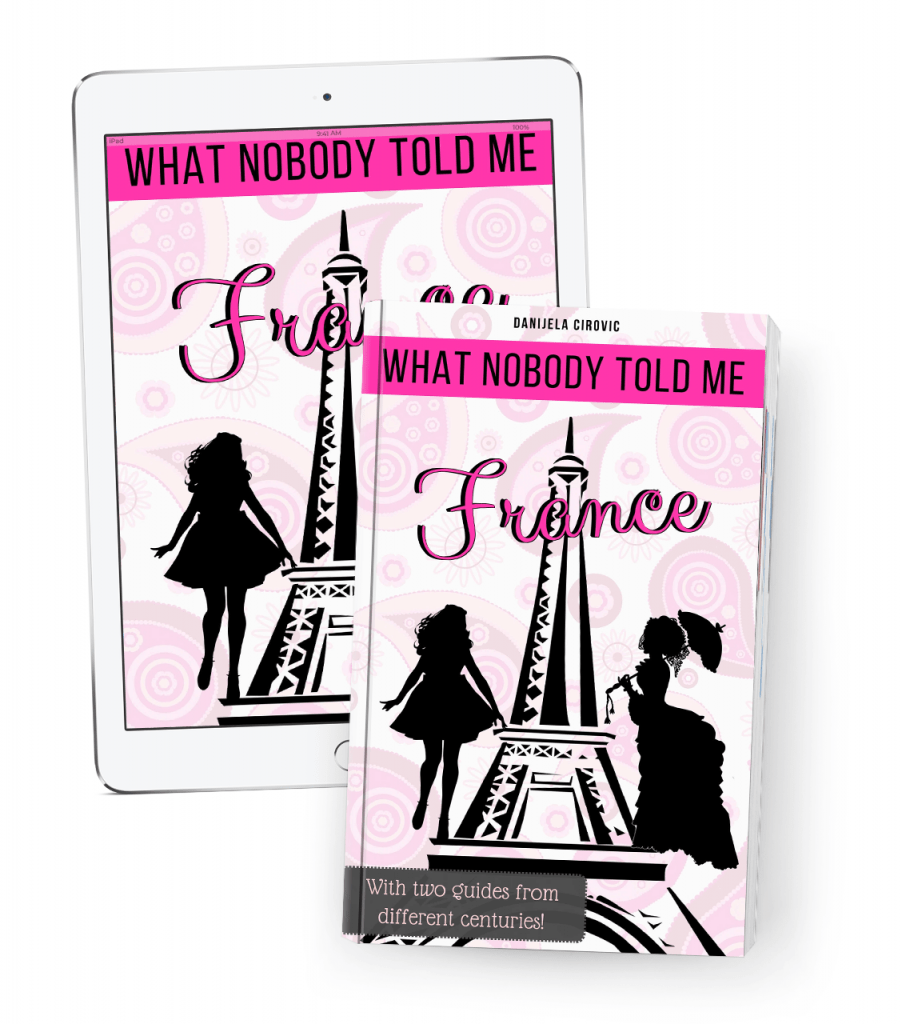
18 responses
Didn’t expect to like Ronda this much, at least judging by your post. This would really be a pity to miss. Love your photos! ❤️ You didn’t get to have lunch properly again? ???? So sorry that the Andalusia series is over, I sincerely enjoyed it. Thanks! ????
Didn’t do well with siestas for some reason. 😀
Thank you, so glad you like the series. I’m a bit sorry to end it as well, but it gives me great joy that I can always come back to Andalusia through my blog.
I’ve been wanting to go to Ronda for ages I’ll definitely keep these in mind for when I do go!
Sure. You are welcome to browse the Andalusia blog series for more info. I’d be happy to help, don’t hesitate to ask. 🙂
Our team is planning a Euro Trip in 2021 & already started the itinerary planning. We also added Spain in your bucket list, but Ronda was not added in our target destinations. But after reading this article, we are considering this place as well.
Thanks a ton for sharing this place.
Oh, thank you so much. I’m so glad I was able to suggest a destination for you. If you are planning a trip to Spain, Andalusia should definitely be on your list. The whole province is just stunning! <3
Ronda is such a beautiful city and so different to some of the tourist spots on the coast. Although we are not fans of bullfighting, the bullring is very impressive. Ernest Hemingway seems to have been to so many places around the world, either fighting or getting drunk in bars.
Not really a fan of bullfighting either, but the museum is worth visiting. And yes, so true about Hemingway. His trails nowadays seem impressive.
Thanks, Marcus. 🙂
Never heard of this town, but being on the cliff looks stunning.
One of the best known white villages of Spain. 🙂
Wow, that canyon is deep like the pearl jam song. Looks a bit scary, but the rest of the town looks lovely.
It looks scary when you see it from below, the canyon and the bridge comes to be huge and impressive. But when strolling the town’s streets, one doesn’t seem to have any idea of the actual settlement’s location. It’s like any other small, charming town. 🙂
Thanks for stopping by.
What a beautiful town and such history! Not sure if i could sit through a bull fight, but i respect where it stands in the town’s history and would definatley visit the museum display. I’ve visited hemingways’ hotel room in havana and his house in key west – maybe i need ot visit ronda to see that side of him.
There’s also a Hemingway’s house in Havana that I found lovely. It was preserved as though he has just left the premises, along with his famous boat being displayed in the courtyard. (There’s a link to that post here in this article.) Would love to see that one in Key West. 🙂
Very interesting and detailed post about Rondo. I’m glad you included the bullfighter museum and Hemingway nuggets. I’ve visited Hemingway’s house in Key West and would love to see more of the places he lived his life.
I just loved Ronda, I think it shows. 🙂
I also visited Hemingway’s house in Cuba. The one in Key West is still on the bucket list. 😉
I didnt know the how beautiful is Ronda. Recently I m planning to go Europe Trip. And it will Definitely be in my bucket list. I will must try Local cinnamon and almond biscuit of Ronda.
Ronda is really unique. If you have the time when traveling through Spain, make sure to stop by. The site of Ronda Bridge is just stunning. 🙂